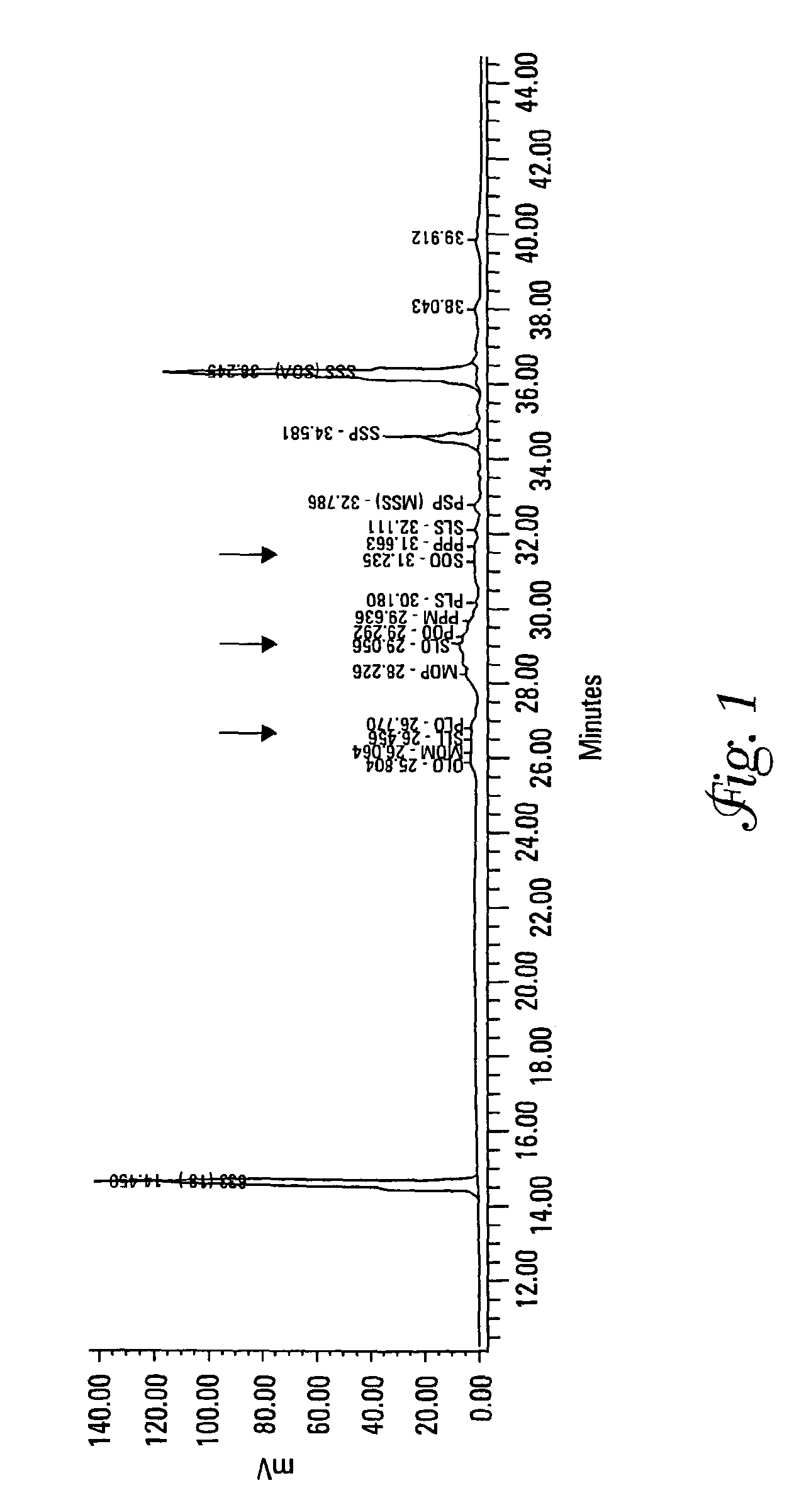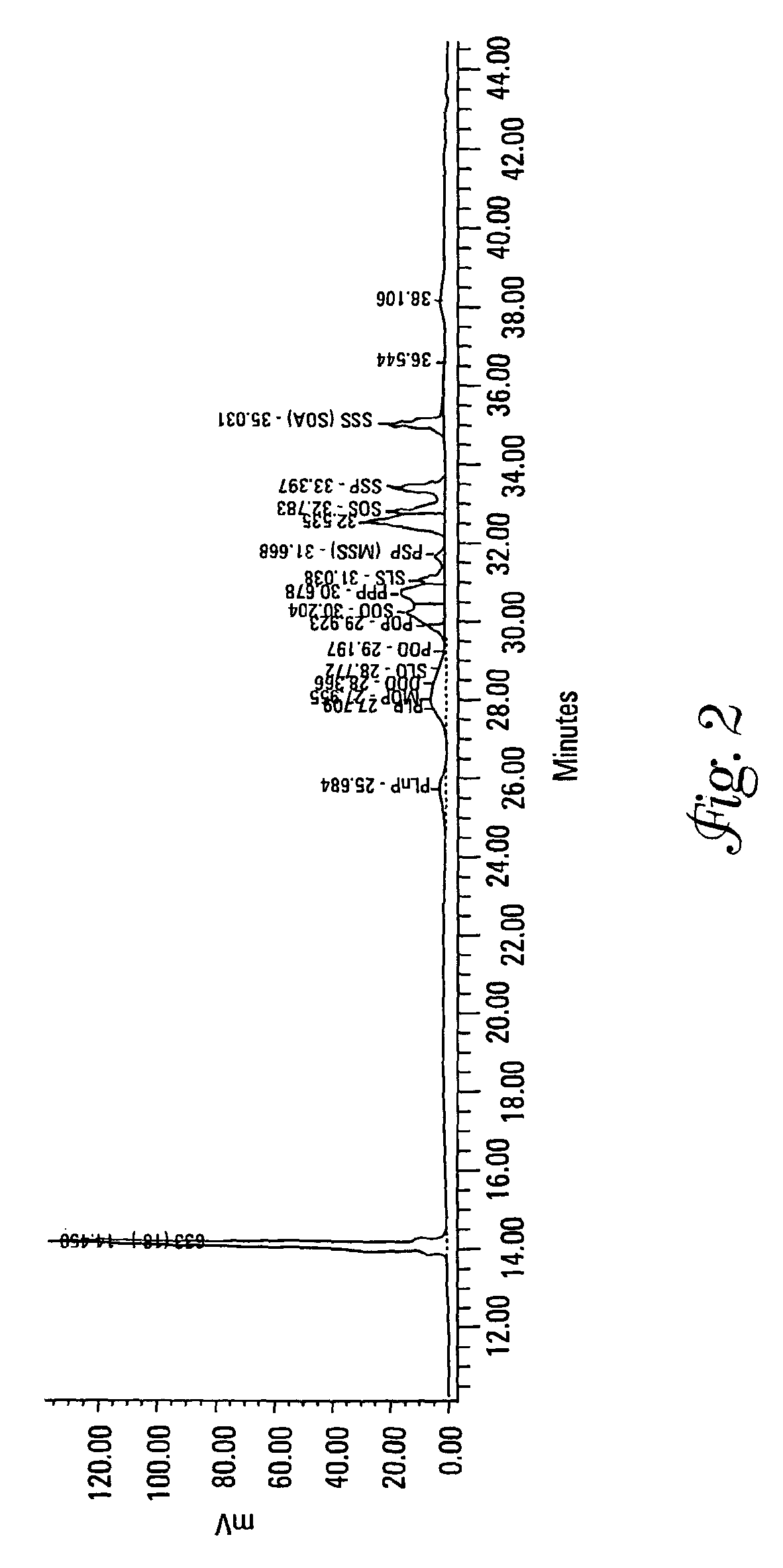Wax and wax-based products
a technology of wax and wax-based candles, applied in the field of wax-based candles, can solve the problems of emitted smoke and bad smell when burning, and the attempts to formulate candle waxes from vegetable oil-based materials have often suffered from a variety of problems, and vegetable oil-based candles have been reported to exhibit one or more disadvantages, and achieve the effect of little soo
- Summary
- Abstract
- Description
- Claims
- Application Information
AI Technical Summary
Benefits of technology
Problems solved by technology
Method used
Image
Examples
example 1
[0127]Interesterification was accomplished by mixing a polyol ester precursor mixture with about 0.1 wt. % sodium methoxide under a vacuum (≦10 mm) atmosphere. The resulting mixture was heated to about 90° C. to 100° C. for thirty to 60 minutes. The reaction was quenched using 80% aq. H3PO4. The resulting product was heated and water was removed via vacuum. Table 1 shows a number of polyol compositions (“precursor mixtures”) that were interesterified under these conditions. Tables 2 and 3 show some physical properties (melting point and solid fat content) of these mixtures before and after, respectively, being subjected to the interesterification reaction.
[0128]
TABLE 1Percentages of Each Precursor Component By WeightSoySoyPalmSampleSoyStea-Hard-Hard-Iodine#RBrinefatfatDimodanH-SSC-RBValue125075000034.5205545000051.1330070000040.0406040000055.6550050000066.560050000505.7745055000060.0805050000046.5905543020050.71004060000037.41102575000023.81240006000053.41300000100040.0
H-SS represen...
example 2
[0132]Each of Samples 2 and 13 from Example 1 were analyzed for their TAG content and DSC curves both as a precursor mixture and as an interesterified wax.
[0133]Triacylglycerols (TAGs) were separated by C18 reversed-phase liquid chromatography (RP-LC) coupled to an evaporative light scattering detector (ELSD). A gradient binary mobile phase system consisting of acetonitrile and methylene chloride was used at 10° C. for the separation. During this run the column chiller stopped working and separations were run at room temperature (approximately 25° C.). This caused a loss of resolution for some of the compounds. The mobile phase flow rate was 0.7 mL / min. The ELSD settings were 35° C., a pressure of 3.5 bar, and nitrogen was used as the nebulizing gas. Calibration curves were log-log linear and based upon triolein (000) as the external standard. The internal standard was a C33 TAG at 10 mg. Standards and samples were diluted in methylene chloride. Soybean oil was used as a reference m...
example 3
[0136]Samples 2 and 13 from Example 1 were also evaluated using differential scanning calorimetry (DSC). The thermal profile performed on the samples included an initial cool from room temperature to −30° C. From −30° C., the sample was heated to 90° C. cooled back to −30° C. and heated back to 90° C. The first up-heat erases all thermal history. The cool down is controlled fast cooling at 40° C. / minute. The second up-heat allows the direct comparison of sample melting characteristics of flash-chilled waxes because of their identical thermal histories.
[0137]Referring to FIG. 5, the first up-heat of Sample 2 Precursor Mixture (2-pre) and Sample 2 Interesterified Wax (2-post) shows a broadening of the melting curve near the melting point when compared to the melting curve of the precursor mixture (2-pre). The high melting fraction and the low melting fraction appeared to have migrated towards each other when the precursor mixture was interesterified and the “sharp spike” observed in t...
PUM
 Login to View More
Login to View More Abstract
Description
Claims
Application Information
 Login to View More
Login to View More - R&D
- Intellectual Property
- Life Sciences
- Materials
- Tech Scout
- Unparalleled Data Quality
- Higher Quality Content
- 60% Fewer Hallucinations
Browse by: Latest US Patents, China's latest patents, Technical Efficacy Thesaurus, Application Domain, Technology Topic, Popular Technical Reports.
© 2025 PatSnap. All rights reserved.Legal|Privacy policy|Modern Slavery Act Transparency Statement|Sitemap|About US| Contact US: help@patsnap.com



